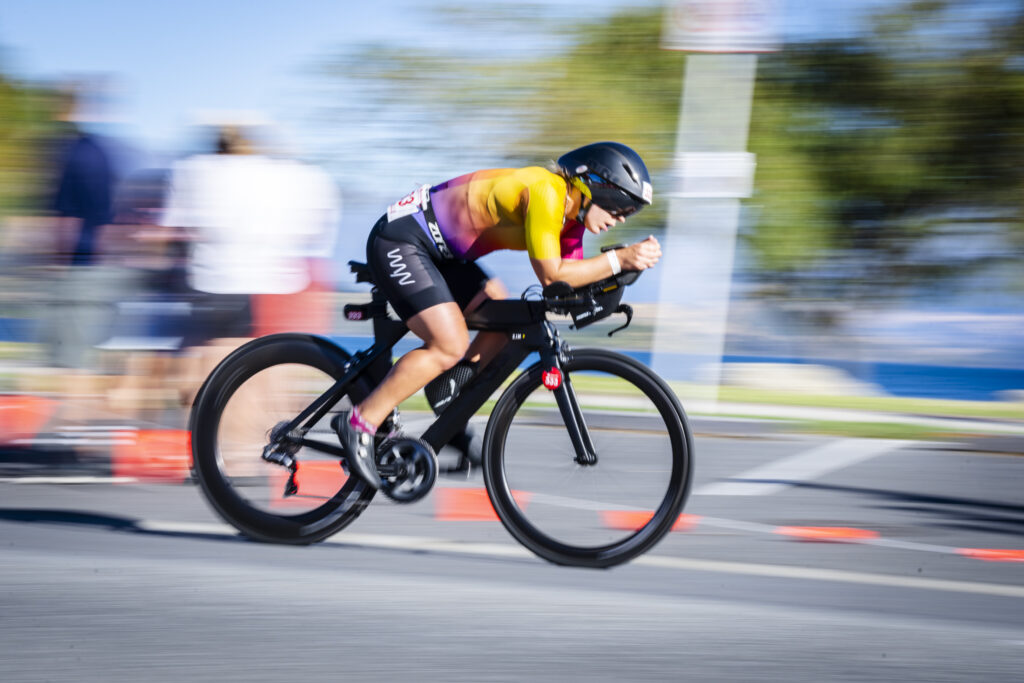RaceRanger Age Group Test Offers Insights on Future Potential and a Glimpse of Athlete Drafting Data

RaceRanger, the draft-detecting technology developed by former pro triathletes James Elvery and Dylan McNiece, took the next step in its evolution last month when 255 age group athletes used the device at Challenge Wanaka.
Elvery and McNiece have been working on the project since 2014, but got serious about it in 2017 thanks to backing from World Triathlon. Jimmy Riccitello, IRONMAN’s head referee, has been working with RaceRanger since 2018. The devices have become a mainstay at pro races over the last couple of years thanks to their use at Professional Triathletes Organisation (PTO) races and the IRONMAN Pro Series last year. This year RaceRanger will provide its services to 37 or 38 pro races around the world.
Tags:
Challenge WanakaRaceRangerContinue the discussion at forum.slowtwitch.com
22 more replies




Excellent article. Some snips of the type of data available in this post:
I’ve linked to this article from that tread.
Some really great data here.
If I’m guestimating the bar graphs right, nearly all of the 255 race ranger using athletes violated the rules.
Just thinking through what that says about the rules… It’s clearly nonsensical to have rules that should penalize everyone but penalize practically no one.
I think the benefit of RR could be to build itself into the rules. I’ve said this elsewhere, but it’s a poor use of a new technology to force it to use old way of thinking.
RR could be built into the rules to give each athlete a target amount of draft zone time and automatically add time to their result as they go over.
Let’s just look at where 70% of the racing population spent time in the draft zone: from the charts it looks like 4 minutes or less.
So for a 70.3 distance RR can say you get up to 4 minutes of draft zone time and then after that every extra second you draft adds 5 seconds to your finish time.
Boom, Race Ranger just codified itself as an integral part of the rules and built an interesting story around the product and the metrics that athletes will use.
The tech is great and the write up here is really interesting. I still can’t see why Ironman would say ‘yes’ to using Race Ranger. What’s in it for them? It would just show that the dirty-not-so-secret (that the 3000 people IM races are draft fests) is as bad or worse than expected.
There’s an important nuance. What you looked at isn’t draft zone time but illegal draft zone time. Maybe that’s what you meant but it isn’t what you wrote.
As AG we have plenty of legal draft time (which the pros can’t do) because you can draft all the way to a pass.
So you would have to approximately add the number of passes * 25 seconds.
Yes of course, I’m referring to illegal time in the draft zone, not time that gets reset because a pass was made.
What’s actually notable about this data as well is when the athletes knew they were being recorded and the data would be analyzed they still ALL violated the rules. I wonder what the results would look like if this was a blind test and they didn’t know their bike had the sensors. I assume even more drafting right? If you’re being watched and you “cheat” this much, surely it must be much more drafting when you’re not being watched?
There’s one aspect I haven’t fully understood. There were under 300 RR out of 3000 athletes.
Did they select a specific wave/age group?
Even if you can try to give the RR to athletes getting out of the water around the same time, you will be often passing athletes that don’t have a RR?
So any measured illegal drafting time would be a subset of the actual drafting time?
–
To answer your question, I think there’s many situations where people would be willing to respect the rules, but as soon as you see others bending them a little, you start doing the same.
Also, to actively play within the rules is a lot more effortful once there are groups around you. You’d have to constantly pass the group and let them pass you.
My experience is that most people don’t do that. They may not be sitting right behind the wheel like at the TDF but they aren’t respecting the rules either.
If the RR athletes were competing against non-RR athletes and see those athletes drafting blatantly, would they respect the rules the same way? Some would some wouldn’t.
Also, there’s situation where it’s objectively more difficult and it’s expected that judges will be closing an eye. Out of transition, steep climb, tight turns, etc. It’s my understanding Wanaka is very hilly.
This was a race of 300 people, not 3000
Based on the article, I understood that 270 people was the size of the specific race that used Race Ranger but that the event was much bigger, although over multiple days.
Now I did some more digging.
Firstly, RR didn’t cover the entire race (still most of it) because only 270 individual athletes had RR while the race was around 300. It’s not clear if it included the invitational part of the race (a handful of athletes).
Also, RR didn’t cover the team race or the aquabike, which have been going on around the same time as the individual event. There was a gap between the starting times but the cycle course was a 3 laps course so there surely was some overlap.
https://www.challenge-wanaka.com/wp-content/uploads/2025/02/CW-2025-Timetable.pdf?x40984
According to the results, at least approximately 230 additional athletes, in addition to the RR athletes, were on the course at the same time as the RR athletes.
I’m not interested in doing further research, but I do think they could have explained it a little better.
If somebody was present or involved, I’m interested in hearing how they think RR affected athlete’s willingness/ability to follow the rules.
This sounds great to me!
@Lurker4’s suggestion (above, time illegally in red flashing over 4 minutes (70.3)) gets a paste and shout (at 13:00 in the GTN video). Extra time to be served at a penalty tent rather than just ‘added’ to an athlete’s time, to have both an immediate effect and a deterrent effect (pour désencourager les autres).
This post wound its way onto GTN’s latest video on the topic.
I think we can quibble about how much grace period to give people, or how harsh the penalty is after you’ve exhausted your grace period, or what the conversion factor might be - but IMO this is the way that RR should be implemented at major events (though once everything’s been vetted and trialed).
Once you’re done, the data is downloaded, you get assessed a penalty based on how well you followed the rules. GTN seemed concerned that newbies would find it off-putting, but something like this isn’t going to be brought out at your local try-a-tri - it will be for your big IM, T100, and challenge events. Start at the WC and work your way down.
Interesting idea, but it also noted each course might need areas where drafting is not a penalty. You mention Ironman, is it drafting time if you are coming in to an aid station? And how do you handle a climb early in the bike course?
Beside those concerns, I do not see many races adding penalties after the fact. First across the line is not the winner?!? That is why Ironman has penalty tents right now. They want the first across the line to be the winner - I know, only a pro issue but still.
Other than for the pros, first across the line hasn’t been a thing for the better part of a decade - so that’s not really an issue. The next gen is going to supposedly have live GPS tracking as their value add, so it isn’t hard to have it de-activate during certain areas of the course either.
I think that the issue that we’re all trying to solve (and why RR was created) is what to do about drafting when the refs aren’t watching - and as we saw, there was a lot of drafting. There were guys that had >20 mins of drafting, even knowing that RR was watching.
I dunno if any solution is going to say “most triathletes need to have an after the fact time adjustment” - but for the egregious folks, by all means hit them with whatever penalty is sufficient to deter them from doing it. But that’s why I said we can quibble about when and how the penalty gets implemented. But at 20 mins you should definitely get something (DSQ???).
Or we could be more elegant, and just say that in order to qualify for the WC, you need to keep your drafting time under 2 mins (or whatever threshold we want to set). That way if you want to blatantly draft, you’re really only cheating yourself.
The data shared show a accurate location for every time ‘Sal Smith’ ‘did’ a thing (over took start and completion), yo-yoed etc. ‘Her’ most egregious yo-yo started just at the Glendhu Bay Lookout and continued (ie drafting) for over 2 minutes.
So the ‘gps’ is there already and the organisers could specify (but not communicate) specific short zones where ‘illegal’ red flashing doesn’t add to the analysed total eg: first mile, aid zone environs, 180s, first 200m of a climb
Using the RR gps for telling spectators etc where an athlete is challenge will be to communicate that in near real time and then use it in lieu of timing mats. That seems doable for the pro field but a challenge for amateur athletes. Afaik ‘they’ haven’t been able to use the gps that pros carry in the small of their back in T100s to give us that data.
Ya, I agree that in the pro you clearly need to have the winner cross the line. so the penalty tent is the way to go.
I’m looking at RR as how can a race, if they chose to use this thing, add value to the organizer as well by eliminating some of the headache of managing penalty tents, officials telling people what they need to do, etc.
It’s pretty straight forward, when you get off the bike, the software will automatically add a penalty time to your time and that’s how far back you are. If you’ve got supporters coaching you from the sidelines, they’ll have to tell you that you need to run even faster than expected, etc. if you’re chasing for the win.
As a newbie, who just shows up at an Ironman, well, you’re mostly oblivious anyway, and when you look at your times, it will show a drafting penalty offset added to your time and a little link that explains what the hell this is. Ideally, they’d already know. And this is WAY easier to explain than all the complicated rules with cards, warnings, penalty tents, where to take the penalty, etc.
You just race the race and the chips fall where they may.
The idea of newbies getting caught surprised by this thing because they make a small mistake isn’t accurate because you’re intentionally, setting that illegal draft limit to something high, like 4 minutes so there is built in grace.
You need that built in grace if you’re going to put a device on someone that purports to track with 100% enforcement. There will be margins or error and circumstances that come into play. The goal for a racer isn’t to “use up” every second of that illegal drafting, but to give you that buffer, much like on the highway no one is getting a ticket for 5mph over unless there are some very clear reasons (school/construction, etc).
Glad to see the idea has legs